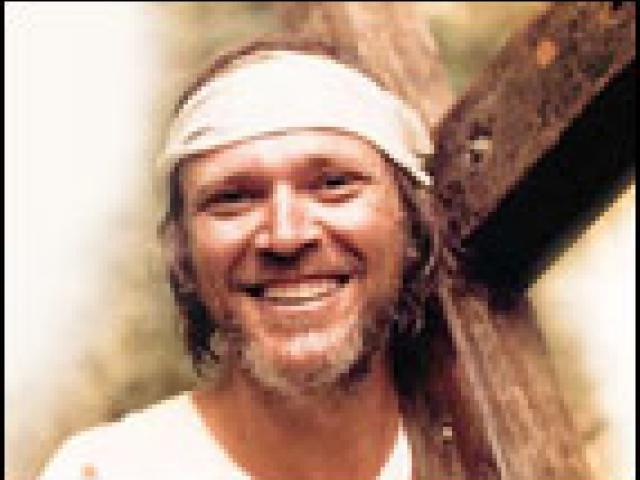Arthur Blessitt: Carrying 'The Cross'

Excerpt adapted from The Cross by Arthur Blessitt (Authentic)
The cross is perhaps the most well-known symbol in the world. From its origin as an instrument of suffering and death it has become—through the suffering and death of Jesus Christ—a symbol of life, love, hope, and salvation. On the third day Jesus arose and ascended to the Father, and now he ever lives to make intercession for us. The good news of the gospel is focused on the cross and the shed blood of Jesus for our sins.
I have had the humbling privilege of giving well over half my life to the calling of carrying the cross from nation to nation. I’ve walked tens of millions of steps. This has been a journey not just of walking, but of walking with a cross—feeling its weight and hearing people’s love or reproach for the cross.
Today, as I was thinking about this chapter, I took a walk with the cross. The sun was shining brightly, so I could see the shadow of me carrying the cross as I moved along the street. Tears filled my eyes as I remembered tough days in the jungles or deserts or war zones. I remembered walking in rain, in snow, in heat, and in cold. I remembered people coming to the cross and finding new life and salvation. And, yes, there have been rejections, but I choose not to magnify those occasions. In the shadow of the cross I have lived, traveled the world, raised seven children, and found welcome and love all around the world.
I am encouraged by what Jesus is doing today. After having carried the cross in every nation, I can say that the world is open to and hungry for the good news of Jesus and the cross. The only problem is that the laborers are few, as Jesus said.
As I complete this mission I feel peace. Jesus is ruling and reigning in the world today. The church is triumphant, and people around the globe are welcoming Jesus. In the shadow of the cross you see firsthand the glorious kingdom of God all around the world. You see the suffering and resurrection of Jesus that has the power to set us free and change our lives. As followers of Jesus, we face great challenges. But Jesus is with us, and he has all power.
I have also felt the agony of the cross as I walked among people suffering from war, hunger, injustice, and oppression. Tears often wash my face as I walk. The weight of the burden of the lost and suffering is heavier than the physical weight of the cross. Yet I walk on . . .
Pain and Passion
Mel Gibson’s film The Passion of the Christ gave many people a new understanding of Jesus’ journey to the cross and the horror of his crucifixion. As I’ve walked, I’ve often wondered what thoughts were in Christ’s mind as he walked toward his crucifixion. Jesus died as a sacrifice for our sins on the cross he carried. I carry the cross to remind people of that incomprehensible sacrifice.
I also wonder what thoughts were in the mind of Simon from Cyrene, who Scripture tells us also carried the cross of Jesus, as he shouldered the wooden cross and made his way beside Jesus through the narrow streets and out the gate to The Place of the Skull. How did Simon feel as he walked beside the bleeding Christ?
While I don’t know for sure what Jesus or Simon thought, I do know that carrying the cross has shaped not only my life but also my physical body. The weight of the cross restricts the blood supply to my arm, so I have to give my right shoulder (my preferred side) a break by moving the cross to my left shoulder from time to time. After years of bearing the weight of the cross, my right shoulder bone has developed about one inch of growth.
Perhaps I’m the only person in history who has been physically shaped by the weight of a cross. But the changes the cross has brought to my physical body are not important. What is important is how the cross has changed my life, and the lives of so many others, from the inside out. I pray that the spiritual weight of the cross has shaped my life according to the example of Jesus.
Taking the Cross Off the Wall
The cross I made from wood, metal, and a wheel is not holy. But it does represent a truly holy event: the crucifixion of the Lord Jesus Christ! The cross is a dramatic symbol of that event. Yet while many people see crosses hanging on walls as decoration, my goal has been to get the cross off the wall and into people’s minds and hearts, where they can understand and experience its message.
A large cross being carried makes an unforgettable impact on the mind of the person who sees it. Years later people still remember when and where they saw the cross being carried.
Symbols are very important in the Bible. In the Old Testament, events such as the Passover are full of symbols. In the New Testament, the bread and wine of Communion represent the body and blood of
Jesus. Baptism and foot washing are other symbols used by believers. In the same way, the cross conveys a profound message when it is seen outside its usual context. Out on the road it touches the hearts of people who have worn a cross necklace for years. Churchgoers see so many crosses, they no longer make an impact; but if those same people leave church and see a person carrying a cross, they are shaken.
Some people have been critical of my walking with the cross around the world, saying, “Jesus has already done that.” Yes, Jesus did carry the cross; but after a short distance Simon was compelled by the Roman soldiers to carry Jesus’ cross. A sinner was qualified to carry the cross of Jesus, but he was not qualified to die on it for our sins.
Simon carried the cross to Calvary. Today we are to carry the cross to the world—maybe not in the literal sense, but as our Lord’s caring representatives.
Jesus spoke often about the cross and its meaning:
“If anyone would come after me, he must deny himself and take up his cross and follow me” (Mark 8:34).
“Anyone who does not carry his cross and follow me cannot be my disciple” (Luke14:27).
“Anyone who does not take his cross and follow me is not worthy of me” (Matthew 10:38).
It is clear from these and other passages that followers of Jesus must be cross-carriers—probably not carriers of a physical cross, but cross-carriers nevertheless.
In Jesus’ day the cross meant one thing: death. It was common for the Romans to use a cross as a way of suppressing occupied peoples. Jesus understood this before he was crucified. And his command that his disciples should carry their own cross implied that those who followed him were prepared to follow him to shame, reproach, and even death.
Jesus called me to carry his cross at five o’clock on a September morning in 1969. That’s what I have been doing ever since. I carry a cross because he called me to do so and because that calling continues. I walk for Jesus because it is his will and plan for my life. That is why I am happy whatever happens. I walk with the cross in the rain, cold, or heat; when loved or hated; when welcomed or rejected; in honor or dishonor.
When I was carrying the cross in Switzerland a man rushed up to me along a city street and said, “You look like the cross.”
I was quite shocked and dismissed his words by saying, “I know I look a bit beat up and rough from the years of walking around the world.”
“No, I don’t mean that,” he replied. “What I mean is that the cross fits you. If I took the cross and started carrying it, it would not look like me. But it does look like you.”
After he left and I was walking down the road, I thought about what he said and came to realize what he meant. I began to weep, praying that my life would indeed look like the cross.
I pray that having walked in the shadow of the cross all these years I look more like Jesus today than when I began.
Order The Cross from ShopCBN





